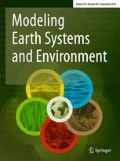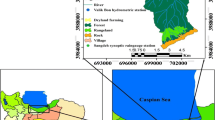Abstract
Intelligent computing tools such as artificial neural networks (ANNs) and fuzzy logic approaches are proven to be efficient when these are individually applied to variety of problems. Recently, there has been a growing interest in combining both of those approaches, and as a result, neuro–fuzzy computing technique has been evolved. This approach has been tested and evaluated in the field of signal processing and related areas. But researches have only begun evaluating the potential of this hybrid approach to hydrologic modeling studies. This paper presents the application of an adaptive neuro–fuzzy inference system (ANFIS) to flood hydrograph modeling, and it is demonstrated by modeling the flood hydrograph flowing to the Shirindarreh Reservoir dam located in the northern Khorasan Province, Iran. This was carried out using 24 flood hydrographs recorded in Barbarqaleh river gauging station. From this dataset, 15 flood hydrographs were chosen to train the model and 6 flood hydrographs to test the model. The different architectures of neuro–fuzzy model according to the membership function and learning algorithm were designed and trained with different epochs. The results were evaluated in comparison with the observed hydrographs and the best structure of model was chosen according the least RMSE in each performance. To evaluate the efficiency of neuro–fuzzy model, various statistical indices such as Nash–Sutcliff and flood peak discharge error criteria were calculated to show the level of agreement between observed and calculated hydrographs. In this simulation, the coordinates of a flood hydrograph including peak discharge were estimated using the discharge values occurred in the earlier time steps as input values to the neuro-fuzzy model. The amount of Nash–Sutcliff criterion for the input patterns of P1, P2, P3 and P4 were 0.82, 0.81, 0.62 and 0.45, respectively. These results indicate the satisfactory efficiency of neuro–fuzzy model, especially in P1, P2 and P3 for flood simulating. This performance of the model demonstrates the suitability of the implemented approach to flood management projects.




Similar content being viewed by others
References
Alpaslan Y, Onucyildiz M, Copty K (2009) Modeling level changes in lakes using neuro- fuzzy and artificial neural networks. J Hydrol 365:329–334
Aqil M, Kita I, Yano A, Nishiyama S (2004) Analysis and forecasting of flow from local source in a river basin using a neuro–fuzzy modeling tool. J Environ Manag 85:215–223
Aqil M, Kita I, Yano A (2007) A comparative study of artificial neural network and neuro–fuzzy in continuous modeling of the daily and hourly behavior of runoff. J Hydrol 337:22–34
Bahremand A, de Smedt F, Corluy J, Liu YB, Poórová J, Velcická L, Kunikova E (2006) Application of Wet Spa model for assessing land use impacts on floods in the Margecany–Hornad watershed, Slovakia. Water Sci Technol 53(10):37–45
Bazartsern B, Hildebrandt G (2003) Short–term water level forecasting using neural networks and neuro-fuzzy approach. Neurocomputing 55:439–450.
Cobaner M, Unal B, Kisi O ( 2009) Suspended sediment concentration estimation by an adaptive neuro-fuzzy and neural network approaches using hydrometeorlogical data. J Hydrol 368:52–61
Dixon B (2004) Applicability of neuro–fuzzy technique in predicting ground water vulnerability a GIS based sensitivity analysis. J Hydrol 309:17–38
Firat M, Güngör M (2007) River flow estimation using adaptive neuro–fuzzy inference system. Math Comput Simul 75(3):87–96
Jang JSR (1993) ANFIS: adaptive network based fuzzy inference system. IEEE Trans Syst Man Cybernation 23(3):665–683
Jang JSR, Sun CT (1997) Neuro–fuzzy and soft computing computinonal approach to learning and Machine Intelligent. Prentice-hall, Eaglewood Cliffs, pp 503–534
Kisi O (2006) Daily pan evaporation modeling using a neuro–fuzzy computing technique. J Hydrol 329:636–646
Luck KC, Ball JE, Sharma A (2003) A study of optimal model lag and spatial input to artificial neural network for rainfall forecasting. J Hydrol 227:56–65
Nayak P, Sudheer K (2004) A neuro–fuzzy computing technique for modeling hydrological time series. J Hydrol 291:52–66
Quarda TBMJ, Shu C (2008) Regional flood frequency analysis at ungauged sites using the adaptive neuro-fuzzy inference system. J Hydrol 349:31–43
Tayfour G, Moramarco T ( 2006) Forecasting flood hydrograph at timber river basin in Italy by artificial neural network. J Hydrol 13 pp
Valenca M, Ludermir T (2000) Monthly stream flow forecasting using a neuro–fuzzy network model. Proceeding of the sixth Brazilian Symposium on Neural. Network 6:117–129
Vernieuwe, andGeorgieva H, O (2005) Comparison of data–driven Takagi–Sugeno models of rainfall – discharge dynamic. J Hydrol 302(1–4):173–186
Acknowledgements
Great thanks to GORGAN University of Agricultural Sciences and Natural Resources for providing necessary facilities for the study. We are also grateful to the staff of the Regional Water Company of northern Khorasan Province, Iran for providing the required data.
Author information
Authors and Affiliations
Corresponding author
Rights and permissions
About this article
Cite this article
Pahlavani, h., Dehghani, A.A., Bahremand, A.R. et al. Intelligent estimation of flood hydrographs using an adaptive neuro–fuzzy inference system (ANFIS). Model. Earth Syst. Environ. 3, 35 (2017). https://doi.org/10.1007/s40808-017-0305-0
Received:
Accepted:
Published:
DOI: https://doi.org/10.1007/s40808-017-0305-0




